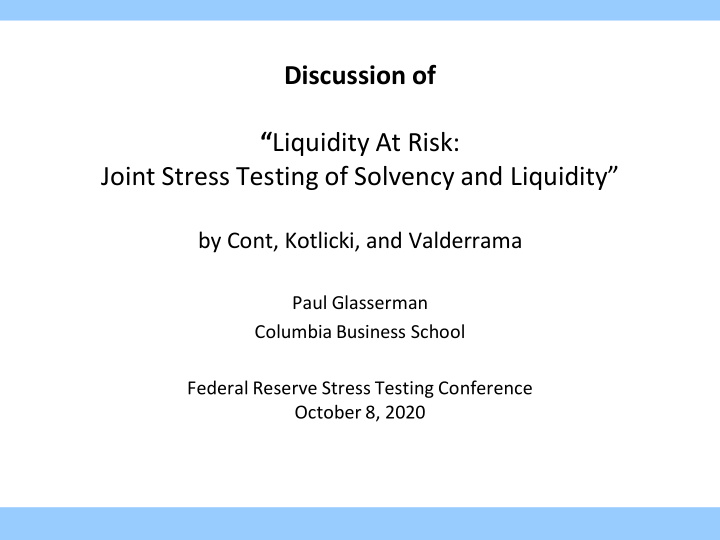



Discussion of “ Liquidity At Risk: Joint Stress Testing of Solvency and Liquidity” by Cont, Kotlicki, and Valderrama Paul Glasserman Columbia Business School Federal Reserve Stress Testing Conference October 8, 2020
Key Contributions of the Paper • Framework for coherent stress testing of liquidity and solvency risk – Shocks to risk factors asset values capital and liquidity • Incorporates bank’s response to liquidity needs – Borrowing (including repo, central bank), fire sales • Feedback cycle between falling asset values and increased cash needs • Liquidity at Risk: additional cash needed conditional on shock • Framework designed for practical implementation using information from bank balance sheets 2
My Questions 1. Does the framework capture all or most important sources of liquidity risk? 2. How does the framework relate to existing measures, including the Liquidity Coverage Ratio? 3
Outlays-Driven Vs. Funding-Driven Liquidity Stress 4
Outlays-Driven Vs. Funding-Driven Liquidity Stress • Paper focuses on outlays-driven stress: – Value of collateral posted by bank drops bank needs to top up – Adverse move in derivatives bank needs to pay variation margin 5
Outlays-Driven Vs. Funding-Driven Liquidity Stress • Paper focuses on outlays-driven stress: – Value of collateral posted by bank drops bank needs to top up – Adverse move in derivatives bank needs to pay variation margin • Doesn’t address draws on credit lines supplied by bank (considered stable) • Doesn’t address funding runs – [Does allow for creditor response to credit downgrade] – Creditors hoard liquidity because they fear they may need it – Creditors pull funding because of uncertainty • Wider haircuts in repo • U.S. prime money market funds cut exposure to European banks in half in 2011-2012 6
Contrast: Liquidity Coverage Ratio • Flows estimated for 30-day stress period • Prospective and conditional measure (paper says “backward looking”) • Uses ad hoc weights, no link to primitive risk factors or asset values 7
JPM LCR Disclosure 2020-Q1 8
JPM LCR Disclosure 2020-Q1 9
Contrast: Liquidity Coverage Ratio • Stressed outflow = stressed outlays + stressed funding withdrawal • Liquidity at Risk: 10
The Liquidity-Solvency Link • Paper’s emphasis is on coherent modeling of liquidity and solvency stress • LCR disconnected from capital, asset values • But U.S. G- SIB surcharge implicitly reflects a “capital cost of liquidity risk” – U.S. G- SIB Method 2 score (unlike Basel’s) includes wholesale funding – Higher score higher capital requirement • How does this implicit link compare with model’s implications? 11
JPM Systemic Risk Report Y-15 – 2020-Q1 • Short-term wholesale funding contributes 115 pts to G-SIB score • Which adds approx. 58 bps to capital requirement • Capital cost of liquidity risk • How does this compare with the paper’s analysis? 12
Summary • Addresses an important question of coherent stress testing of liquidity and solvency risk • Relative to existing regulatory framework, puts less emphasis funding runs as a source of liquidity risk – But this can be addressed • Systematic comparison with LCR would be welcome • Paper has a welcome focus on making the results practical for implementation 13
Recommend
More recommend